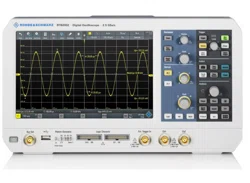Loading ...
Loading ...
Loading ...

Waveform Setup
R&S
®
RTB2000
41User Manual 1333.1611.02 ─ 03
"AC"
AC coupling is useful if the DC component of a signal is of no inter-
est. AC coupling blocks the DC component of the signal so that the
waveform is centered on zero volts.
"DC"
With DC coupling, the input signal passes unchanged, all signal com-
ponents are shown.
Remote command:
CHANnel<m>:COUPling on page 254
Ground
Connects the input to a virtual ground. All channel data is set to 0 V. Ground connec-
tion is labeled with
. The coupling is not affected by the ground setting.
Remote command:
CHANnel<m>:COUPling on page 254
Bandwidth
Selects the bandwidth limit. The specified full bandwidth indicates the range of fre-
quencies that the instrument can acquire and display accurately with less than 3 dB
attenuation.
For analog applications, the highest signal frequency determines the required oscillo-
scope bandwidth. The oscilloscope bandwidth should be at least 3 times higher than
the maximum frequency included in the analog test signal to measure the amplitude
without aliasing.
Most test signals are more complex than a simple sine wave and include several spec-
tral components. A digital signal, for example, is built up of several odd harmonics. For
digital signals, the oscilloscope bandwidth should be at least 5 times higher than the
clock frequency to be measured.
The oscilloscope is not an autonomous system. You need a probe to measure the sig-
nal, and the probe has a limited bandwidth, too. The combination of oscilloscope and
probe creates a system bandwidth. To reduce the effect of the probe on the system
bandwidth, the probe bandwidth should exceed the bandwidth of the oscilloscope, the
recommended factor is 1.5 x oscilloscope bandwidth.
"20 MHz"
Frequency limit. Higher frequencies are removed to reduce noise.
Limited bandwidth is indicated by "B
W
" in the waveform label.
"Full"
At full bandwidth, all frequencies in the specified range are acquired
and displayed. Full bandwidth is used for most applications.
Remote command:
CHANnel<m>:BANDwidth on page 254
Invert
Turns the inversion of the signal amplitude on or off. To invert means to reflect the volt-
age values of all signal components against the ground level. Inversion affects only the
display of the signal but not the trigger.
For example: if the oscilloscope triggers on the rising edge, the trigger is not changed
by inversion, but the actually rising edge is displayed as falling edge.
Inversion is indicated in the waveform labels by line above the channel name.
Vertical Setup
Loading ...
Loading ...
Loading ...
